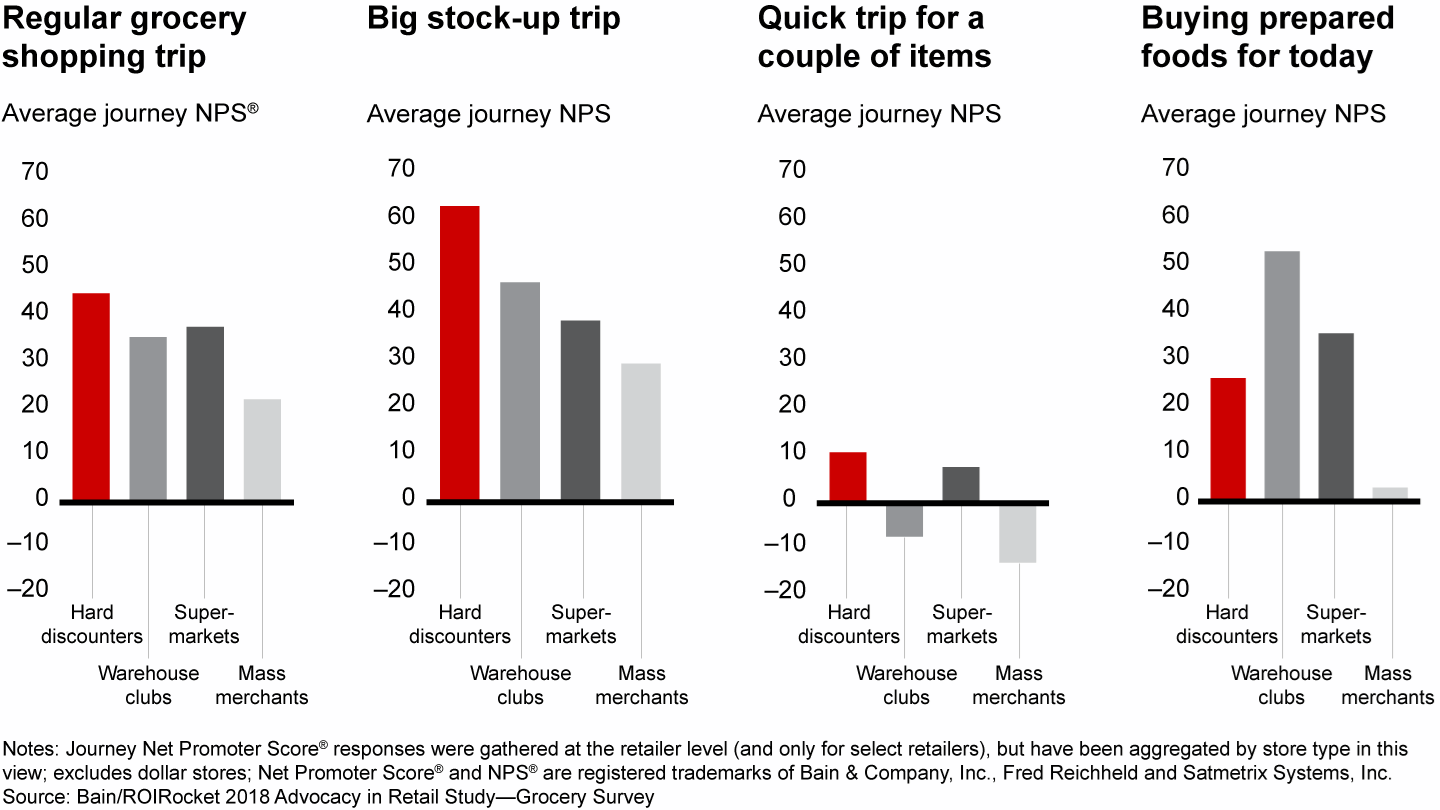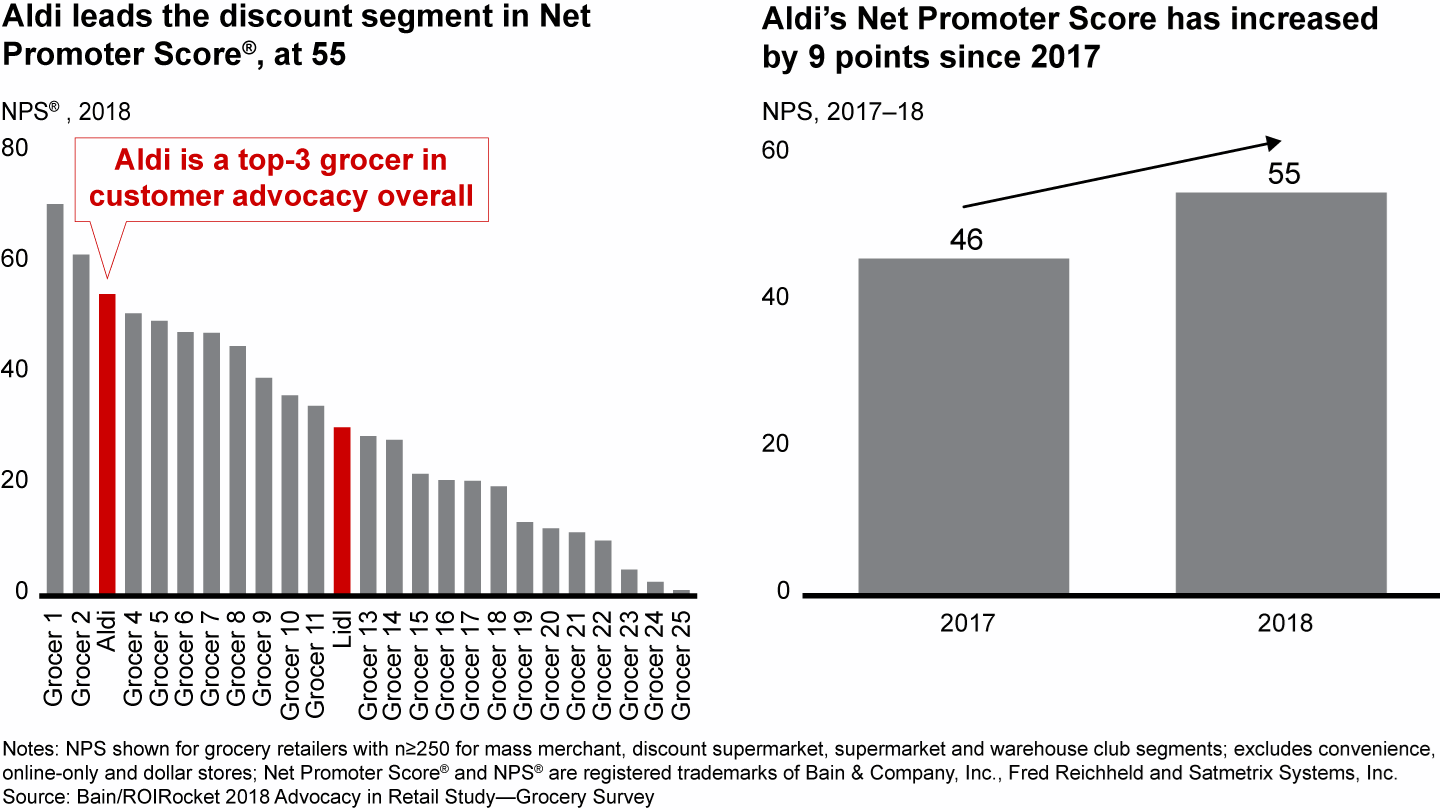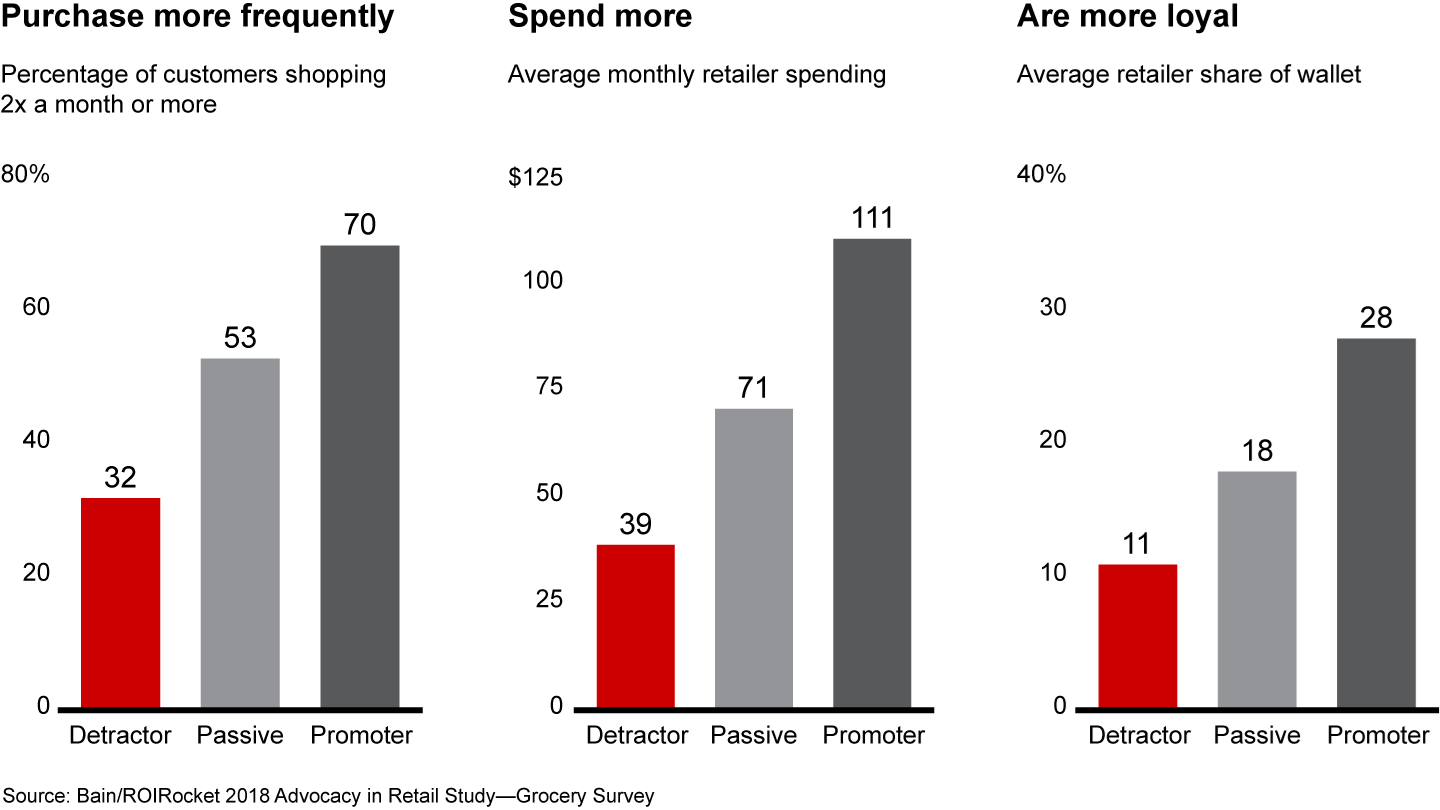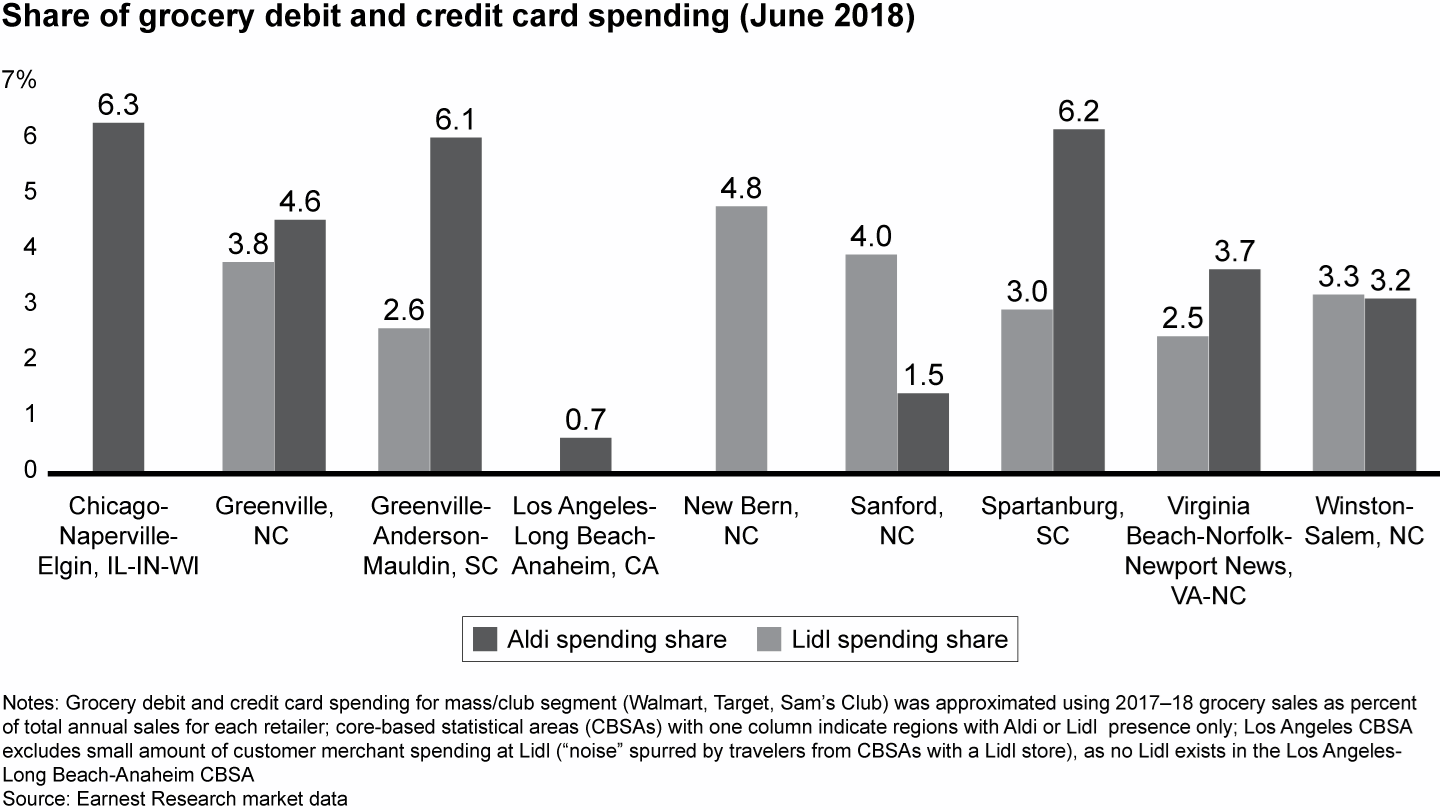Brief

Резюме
- While Europe’s hard discounters Aldi and Lidl haven’t proved to be devastating competition for US grocers, they are steadily learning what works for them in the US market—meaning that established grocers need to flex their competitive muscles.
- US grocers can stand up to hard discounters by competing on price, investing in private labels and fresh food, and by getting their costs under control.
- However, two other moves gained significance in the last year for traditional US grocers hoping to gain an edge over hard discounters: investments in convenience and reliance on advanced analytics (or other advanced technologies) to improve operational efficiency.
Last year, traditional grocers in the US braced for the entry of Lidl and ambitious expansion by Aldi, the hard discounters that transformed the nature of grocery retailing in Europe and threaten to do the same in North America. The popular media narrative over the past year has been that Lidl’s launch was underwhelming and that Aldi’s coverage has been limited. However, we strongly believe that hard discounters should not be underestimated, as their slow and steady gains still represent a growing competitive challenge for incumbents.
As we noted in our Bain Brief in May 2017 (“Getting Ready to Battle Grocery’s Hard Discounters”), hard discounters have many things working in their favor. Like their European counterparts, US shoppers who try the format typically like it. In Bain & Company’s recent Advocacy in Retail Study of more than 17,400 consumers, conducted in partnership with ROIRocket, we found that hard discounters lead in customer advocacy out of all grocer types for three of the four main shopper journeys, based on the Net Promoter System®, a popular method for gauging customer advocacy (see Figure 1). Also, wherever those stores are available, US shoppers are often willing to add Lidl or Aldi to their shopping repertoire. In three representative US markets studied, there is a significant rate of cross shopping—as many as 30% of shoppers at mass and traditional grocery stores also shop at Lidl and Aldi.
Hard discounters lead in Net Promoter Score® across majority of shopper journey types


Both of these retailers use their strong customer advocacy and ability to lure consumers into cross shopping as a wedge to build up their presence and popularity in the US.
Aldi, a discounter mainstay in the US market with big growth ambitions, continues to win over American shoppers. Its consumer advocacy rose to 55% in 2018 from 46% a year earlier (see Figure 2). It outperformed in the two areas customers care about most: “best everyday low prices” and “best value for the money.” Consumer advocacy is a predictor of future success, as promoters (a company’s biggest fans) purchase more than twice as frequently as detractors (consumers giving a company a low rating). For example, promoters in general spend much more—$111 vs. $39 on average per month—and give retailers a higher “share of wallet”—28% for promoters vs. 11% for detractors (see Figure 3).
Aldi has strong customer advocacy, which has increased by 9 points in the past year


Customer advocacy is crucial to success within grocery. Promoters are extremely valuable across dimensions as they …


These factors have translated into strong market performance and slow but steady gains. In a summer 2018 study conducted in partnership with Earnest Research, a data innovation company, we looked at representative markets to understand share performance based on debit and credit card spending data. Aldi has more than 3% share of grocery spending in six of the eight markets studied, and has seen share gains in the majority of those markets over the last two years (see Figure 4).
Aldi averaged 4% share of grocery spending in areas analyzed, while Lidl averaged 3%, despite entering only one year earlier


To maintain its momentum in the US, Aldi is investing heavily. For example, the grocer launched a $3.4 billion expansion program with the goal of increasing its footprint from 1,800 stores to 2,500 stores by 2022. It also embarked on a $1.6 billion remodeling program to update and expand 1,300 stores while widening its product selection. Now, 20% of the items in every Aldi store will be new, and each location will offer more fresh, organic and easy-to-prepare items. Aldi will roll out its Instacart (online ordering and delivery) service to all its stores across 35 states, catching up in an area where it has traditionally lagged competitors. Meanwhile, it is heavily promoting its high-value, low-price advantage. All told, Aldi has doubled its sales volume over the last five years, a record that Aldi’s US CEO, Jason Hart, hopes to repeat over the next five years.
The other German giant, Lidl, entered the US in 2017. Some early headlines reported a disappointing American experience for Lidl in America, and it clearly has encountered hurdles in its ambitious growth plan. Yet, while the company is not likely to meet its own lofty near-term expectations, the data paints a different picture for the future.
For a newcomer, Lidl is actually quite impressive in its performance. Lidl has captured 3% or more share in five of the seven markets studied in the summer of 2018, gaining spending from traditional grocers.
Lidl admittedly has taken a more measured approach to entering the US than it originally planned, opening about 50 stores compared with the 100 it announced last year. Rather than reflecting a failure to launch, the slowdown in store openings suggests a strategic reset aimed at helping Lidl learn as its US team translates the store’s traditional value proposition and format to the American grocery market. As part of that reset, Lidl announced in November that it would acquire 27 Best Stores in Long Island, New York, and in New Jersey, and convert those stores to the Lidl banner. It’s a move that gives Lidl a solid footprint in the greater New York area, where it operates only three stores.
The hard discounter appears to know how to pivot. For example, its large store format, combined with a lack of urban foot traffic in its array of mid-Atlantic locations, may have posed profitability challenges. Now the retailer is temporarily regrouping by reconsidering both its store size and expansion plans. It is focusing more on higher-density, higher-traffic locations, for example.
As both Aldi and Lidl carefully plot their US expansion, traditional grocers will need to similarly plan for dealing with these hard discounters, who remain a formidable competitive threat—particularly as they demonstrate an ability to learn as they grow.
In our 2017 Bain Brief, we discussed how price is first and foremost in any competition with hard discounters. Therefore, tackling the price perception between incumbents and hard discounters is table stakes. Grocers achieve this through price investment, focusing on known value items (KVIs) or targeted promotions, among other steps. In addition, we also spelled out five rules for competing in this changing grocery landscape—and even growing share amid the broader disruption caused by the hard-discount format:
- Embrace your own private brands before your shoppers embrace someone else’s.
- Lead with fresh.
- Get more convenient while your competitors get less so.
- Transform your cost structure, don’t just tweak it.
- Use advanced analytics to unlock new sources of value.
While all five remain important, two have gained in significance since last year. These are investments in convenience and the reliance on advanced analytics (or other advanced technologies) to improve operational efficiency.
First, let’s revisit three proven rules.
With private label sales steadily outpacing national brands in growth, grocers are investing heavily in private labels. They know that if they do not embrace private brands, shoppers will embrace someone else’s. Consider how Costco continues to accelerate the growth of its Kirkland brand, putting pressure on national brands in the battle for shelf space. Target hired senior management to strengthen its private brands business, and Amazon has heartily welcomed Whole Foods’ 365 family of brands, which it promotes on its site.
Traditional retailers also are gearing up to win in the perception battle over fresh produce and high-quality groceries. Publix and H-E-B are building new fresh-market stores, changing the shopper experience and highlighting quality. Among the moves: offering olive oil tasting bars and hiring chefs and restaurateurs to work in-store.
Grocers continue to transform their cost structure, too, often using zero-based approaches to achieve the sustained cost reductions needed to both generate investment dollars and maintain financial returns. Kroger has installed electronic temperature monitoring in stores, deploying technology to monitor and manage checkout lane queues, and is exploring avenues for cashierless shopping—all aimed at reducing costs. It also has partnered with the retail technology firm Ocado to rely on highly automated warehouses that improve fulfillment efficiency and future profitability.
Two vital strategic moves
While those three steps are important, two strategic moves are surfacing as the most crucial for battling hard discounters: investing to make shopping convenient and relying heavily on advanced analytics and disruptive technologies. We’ll look at both in detail.
Pursuing the vast opportunities in convenience. After good value and price, convenience was the third-most-popular reason shoppers try Aldi, according to last year’s survey. Since that time, convenient offerings, such as click-and-collect grocery pickup, have become an even bigger contributor to sales for incumbents and hard discounters alike, as shoppers’ expectations of convenience and service levels keep growing. Convenience could mean expanding a grocer’s presence, creating new formats and providing better options in existing stores.
Major grocers are investing in convenience. Consider how Amazon/Whole Foods reset customer expectations of what speed can look like with its Amazon Go format. While the retailer has opened only five locations to date, it is rumored to be offering as many as 3,000 sites throughout the US by 2021. Other big moves include rolling out home delivery from Whole Foods and expanding the geographical reach and assortment of Prime Now two-hour delivery, putting greater emphasis on grocery. Walmart now offers free curbside pickup at 1,800 locations and has heavily invested to improve the omnichannel experience. It is in the process of expanding online grocery delivery to 40% of households and installing 700 automated in-store pickup towers. The retailer also is piloting the use of Waymo autonomous vehicles to enable customers to pick up their groceries ordered online.
Indeed, grocers can gain an edge over hard discounters by investing in omnichannel to make online and offline a seamless shopper experience. Fully 26% of our retail customer advocacy survey respondents report shopping online for groceries—and these shoppers are more valuable than those who limit their purchases to physical stores. Online customers buy more frequently (75% of online customers shop twice a month or more compared with 52% of offline-only shoppers). They also spend significantly more—an average $122 per month compared with $63 per month—and are more loyal.
The good news for incumbents is that this is a prime area for differentiation. Consider that only 1% of surveyed Aldi shoppers report having purchased groceries online. While we expect Aldi’s online penetration to grow over time, by comparison, 26% of shoppers at the best-performing established grocers report that they shop online. We expect that segment to grow as retailers invest in improving the customer experience for both delivery customers and for those who buy online and pickup in store.
Using advanced analytics (and other disruptive technologies) to unlock new sources of value. This is another key area in which incumbents can aggressively fight back against hard discounters. As the cost of data plummets while overall computational power and ability rises, established grocers will need to be increasingly strategic about how and where they use advanced analytics and digital technologies. Applying rigorous analytics to shopper purchasing data can boost the sophistication of assortment decisions and give a grocer negotiating leverage with suppliers. The key input is determining how shoppers truly shop categories, which is not always the way merchants have historically structured them (see the Bain Brief “How Grocers Buy Better for Growth”).
With its acquisition of the research firm 84.51°, Kroger is taking grocery data analysis to the next level. The grocer refreshes sales forecasting on a nightly basis for each item in more than 2,700 stores, and uses purchase data from 60 million households to create holistic promotional campaigns. Similarly, Amazon is expected to integrate high-frequency, real-time data across platforms, including in-store data from Whole Foods, to build out a massive repository that helps it better target marketing, improve assortment and optimize its supply chain.
These and other leaders are on the right path. Based on our research, companies that use big data are two times more likely to have top-quartile financial performance than their less tech-savvy competitors are. Frontrunners anticipate significant, transformative returns on their investments in retail analytics as they benefit from machine-enabled decision making, customer personalization and other applications.
The trouble is, only 5% of grocers surveyed name analytics as an important priority. While investments in retail analytics start-ups have increased more than fourfold since 2014, almost a third of grocers still lack a clear strategy for embedding data and analytics effectively. However, as leading grocers gain ground, followers will need to spend exponentially just to stay in the game.
While hard discounters’ expansion into the US turned out not to be as overwhelming as many expected, it still will be disruptive—if not tumultuous—for traditional grocers who are slow to make the proactive moves that will help them differentiate. Learning to live with—and outperform—hard discounters means competing on price, rethinking private labels, investing in fresh food and rigorously attacking costs. Above all, though, the biggest opportunities to get out ahead of hard discounters now lie in finding new ways to define convenience, and relying more heavily on advanced analytics to give shoppers what they want.
Kent Knudson and Mikey Vu are Bain & Company partners based in Chicago. Both are members of the firm’s Retail practice. The authors would like to thank Carlyn Kinn and Adanna Ukah for their contributions to this Bain Brief.
Net Promoter®, Net Promoter System®, Net Promoter Score® and NPS® are registered trademarks of Bain & Company, Inc., Fred Reichheld and Satmetrix Systems, Inc.

Cultivating Grocery Customers
Grocers eyeing an uncertain future should not forget why their current customers love them.